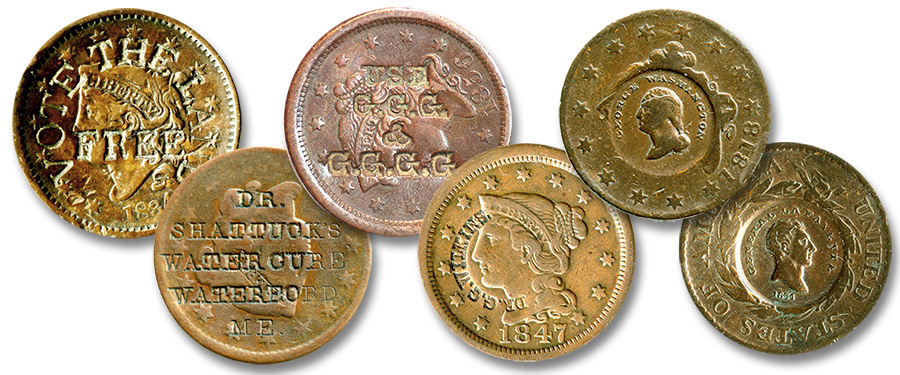
Over a long period of years and in
many different countries, legal tender coins have been counterstamped for
various reasons, including changing the face value, indicating where the coins
were to circulate, and to advertise products and services.
I
have a long-time personal connection to counterstamps, especially on
cents. When I was a teenager in the mid 1850s, I could not afford to collect
“regular” large cents. Even back then a nice 1793 would cost into the hundreds
of dollars. However, well within my budget were counterstamped cents bearing advertisements,
political slogans, and other notices. These often cost just a dollar or two,
rarely more than five dollars. Before long, I became interested in
counterstamps on other coins as well, especially on silver coins prior to the
Liberty Seated series.
When
Lafayette paid a return trip to the United States in 1824, thousands of copper
cents were stamped with his portrait on one side and Washington’s on the other.
I have perhaps a half dozen different cent dates with such. Whitten’s Golden
Salve, a long-forgotten product, is memorialized today on a counterstamped cent
I’ve owned for many years, keeping good company with a hundred or more
silversmiths’ hallmarks impressed on coppers.
Among
my favorites is VOTE THE LAND FREE, a plentiful counterstamp that evokes a
presidential election campaign of the 1840s. It was a double entendre, as
adherents thought the government should provide free land to homesteaders and,
separately, the land of America should be free from slavery. Dr. G.G. Wilkins,
a dentist in Pittsfield, New Hampshire, was America’s most prolific user of
counterstamped cents to promote his business. While not as prolific, Dr.
Shattuck’s Water Cure in Maine also advertised the same way. Fascinated by the
story behind both of these, I wrote a monograph about Wilkins and a large book
about Shattuck.
Perhaps
significant: I find counterstamped coins every bit as interesting and
fascinating today as I did in the 1950s when, a few years after meeting the
proprietors of the Copley Coin Company, I bought Maurice Gould’s personal
collection—which had been featured in the pages of The Numismatist and elsewhere.
This week I share some counterstamps
that were legal tender in the United States, on American coins as well as
foreign issues. It is fascinating to track down information about the issuers
via directories and newspapers on the internet.





